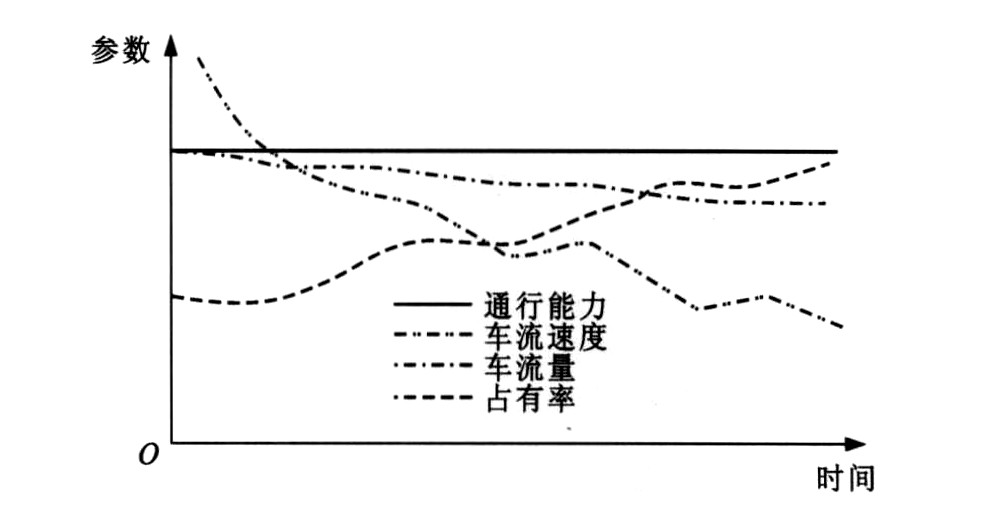Detection method of traffic state for urban traffic network based on wavelet analysis
-
摘要: 选取交叉口进口饱和度和路段平均行程速度作为路网状态检测的基本参数, 采用小波包变换的时频高分辨率特性, 以能量分析方法识别进口饱和度和路段平均行程速度的突变与异常状况, 并定义了交通状态系数来定量描述交通状态变化, 设计了基于小波分析的交通状态检测算法, 并采用贝叶斯算法对交通状态进行预测。仿真分析结果表明: 小波包变换可有效识别节点能量分布的突变区间, 据此可准确判别交通状态发生变化的时段; 当采样数据的模极大值点为200~243时, 此段节点能量变化比较剧烈, 信号在此出现突变, 由较平稳向非平稳状态变化, 对应的路段交通状态系数大于0.300h.km-1, 为拥挤状态。该方法原理简单, 检测响应时间短, 检测结果可靠。Abstract: The import saturation degree of intersection and the average travel speed of road section were selected as the basic parameters of road network's state detection, the high time-frequency properties of wavelet packet transform was adopted, and the mutation and unusual conditions of the saturation and the speed were distinguished by using energy analysis method. In order to describe the change of traffic state, a coefficient was defined, a traffic state detection algorithm was designed by using wavelet analysis, and Bayesian Method was used to predict the traffic state. Simulation result shows that the mutation interval of energy distribution can be identified by using wavelet analysis, based on which the changing time interval of traffic state can be distinguished. While the maximal points of sampling data modulus are from 200 to 243, the energy change of the section node is intense, and the state changes from steadiness to unsteadiness. When the coefficient of traffic state is more than 0.300 h·km-1, a crowded state appears. The method with simple working principle and short time response to congestion is feasible because of its credible detection result.
-
表 1 服务水平与饱和度
Table 1. Saturations and service levels
服务水平等级 饱和度 服务水平等级 饱和度 A ≤0.3 D (0.7, 0.8] B (0.3, 0.6] E (0.8, 0.9] C (0.6, 0.7] F > 0.9 表 2 交通状态系数临界值
Table 2. Critical values of traffic state coefficient
交通状态 交叉口进口饱和度 平均行程速度/(km·h-1) 交通状态系数临界值/(h·km-1) 畅通与轻微拥挤 0.3 30 0.099 轻微拥挤与拥挤 0.6 20 0.300 拥挤与严重拥挤 0.9 10 0.900 表 3 交通状态系数
Table 3. Traffic state coefficients
路段编号 交叉口进口饱和度 平均行程速度/(km·h-1) 交通状态系数/(h·km-1) 1 1.00 13.2 0.758 2 0.88 14.7 0.599 3 0.89 14.1 0.631 4 0.95 10.5 0.905 5 0.88 11.8 0.746 6 0.76 21.3 0.357 7 0.81 18.2 0.445 8 0.93 15.2 0.612 9 0.73 20.8 0.351 10 0.62 22.6 0.274 11 0.53 24.5 0.196 12 0.45 27.1 0.166 -
[1] GIESA S, EVERTS K. ARI AM: car-driver-radio-informa-tion on the basis of automatic incident detection[J]. Traffic Engineering and Control, 1987, 28(6): 344-348. [2] ABDULHAI B, RITCHIE S G. Enhancing the universality and transferability of freeway incident detection using a Bayesian-based neural network[J]. Transportation Research Part C: Emerging Technologies, 1999, 7(5): 261-280. doi: 10.1016/S0968-090X(99)00022-4 [3] FAISAL A. Incident detection: selection of appropriate tech-nologies and methodologies[J]. Road and Transport Research, 2002, 11(2): 50-56. [4] THAM Y K. Network design for simultaneous traffic flow requirements[J]. IEICE Transactions on Communications, 1997, E80-B(6): 930-938. [5] ADELI H, KARI MA. Fuzzy-wavelet RBFNN model for freeway incident detection[J]. Journal of Transportation Engineering, 2000, 126(6): 464-471. doi: 10.1061/(ASCE)0733-947X(2000)126:6(464) [6] XIONG Zi-xiang, RAMCHANDRAN K, ORCHARD M T. Wavelet packet image coding using space-frequency quantiza-tion[J]. IEEE Transactions on Image Processing, 1998, 7(6): 892-898. doi: 10.1109/83.679438 [7] 张敬磊, 王晓原. 交通流状态辨识小波算法研究[J]. 武汉理工大学学报: 交通科学与工程版, 2006, 30(5): 820-823. doi: 10.3963/j.issn.2095-3844.2006.05.022ZHANG Jing-lei, WANG Xiao-yuan. Study on traffic flow condition identification using wavelet method[J]. Journal of Wuhan University of Technology: Transportation Science and Engineering, 2006, 30(5): 820-823. (in Chinese) doi: 10.3963/j.issn.2095-3844.2006.05.022 [8] 庄斌, 杨晓光, 李克平. 道路交通拥挤事件判别准则与检测算法[J]. 中国公路学报, 2006, 19(3): 82-86. doi: 10.3321/j.issn:1001-7372.2006.03.015ZHUANG Bin, YANG Xiao-guang, LI Ke-ping. Criterion and detection algorithm for road traffic congestion incidents[J]. China Journal of Highway and Transport, 2006, 19(3): 82-86. (in Chinese) doi: 10.3321/j.issn:1001-7372.2006.03.015 [9] 林士敏, 田凤占, 陆玉昌. 贝叶斯网络的建造及其在数据采掘中的应用[J]. 清华大学学报: 自然科学版, 2001, 41(1): 49-52. doi: 10.3321/j.issn:1000-0054.2001.01.013LI N Shi-min, TI AN Feng-zhan, LU Yu-chang. Construction and applications in data mining of Bayesian networks[J]. Journal of Tsinghua University: Science and Technology, 2001, 41(1): 49-52. (in Chinese) doi: 10.3321/j.issn:1000-0054.2001.01.013 [10] 刘伟铭, 管丽萍, 尹湘源. 基于决策树的高速公路事件持续时间预测[J]. 中国公路学报, 2005, 18(1): 99-103. doi: 10.3321/j.issn:1001-7372.2005.01.020LI U Wei-ming, GUAN Li-ping, YI N Xiang-yuan. Prediction of freewayincident duration based on decision tree[J]. China Journal of Highway and Transport, 2005, 18(1): 99-103. (in Chinese) doi: 10.3321/j.issn:1001-7372.2005.01.020 [11] 张和生, 张毅, 胡东成, 等. 区域交通状态分析的时空分层模型[J]. 清华大学学报: 自然科学版, 2007, 47(1): 157-160. https://www.cnki.com.cn/Article/CJFDTOTAL-QHXB200701041.htmZHANG He-sheng, ZHANG Yi, HU Dong-cheng, et al. Spatial-temporal hierarchical model for area traffic state analysis[J]. Journal of Tsinghua University: Science and Technology, 2007, 47(1): 157-160. (in Chinese) https://www.cnki.com.cn/Article/CJFDTOTAL-QHXB200701041.htm [12] 李晓丹, 刘好德, 杨晓光, 等. 城市道路网络交通状态时空演化量化分析[J]. 系统工程, 2008, 26(12): 66-70. https://www.cnki.com.cn/Article/CJFDTOTAL-GCXT200812014.htmLI Xiao-dan, LI U Hao-de, YANG Xiao-guang, et al. Quan-titative analysis of space-time evolution of traffic status for urban road network[J]. Systems Engineering, 2008, 26(12): 66-70. (in Chinese) https://www.cnki.com.cn/Article/CJFDTOTAL-GCXT200812014.htm [13] 郭艳玲, 吴义虎, 黄中祥. 基于小波分析和SOM网络的交通事件检测算法[J]. 系统工程, 2006, 24(10): 100-104. https://www.cnki.com.cn/Article/CJFDTOTAL-GCXT200610020.htmGUO Yan-ling, WU Yi-hu, HUANG Zhong-xiang. An algo-rithmfor traffic incidents detection based on wavelet analysis and SOMnetwork[J]. Systems Engineering, 2006, 24(10): 100-104. (in Chinese) https://www.cnki.com.cn/Article/CJFDTOTAL-GCXT200610020.htm -





 下载:
下载:










